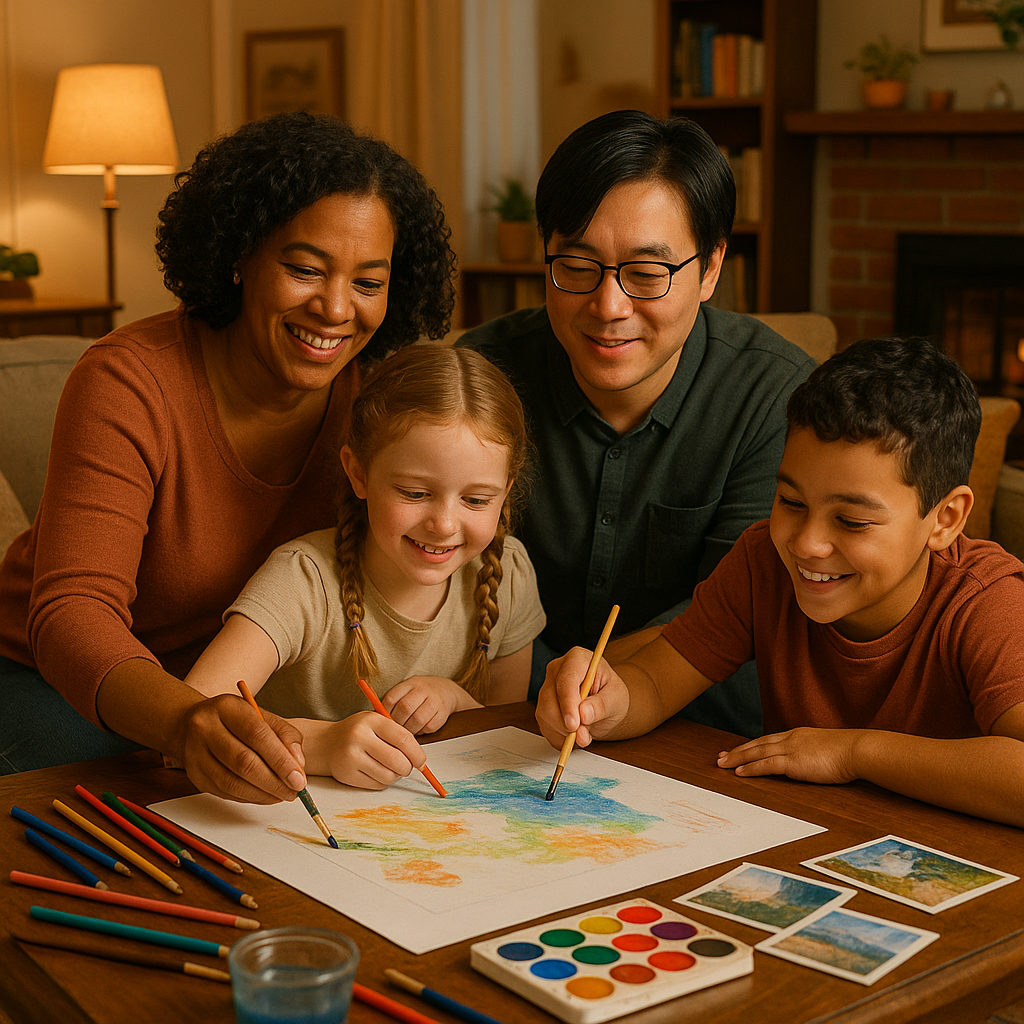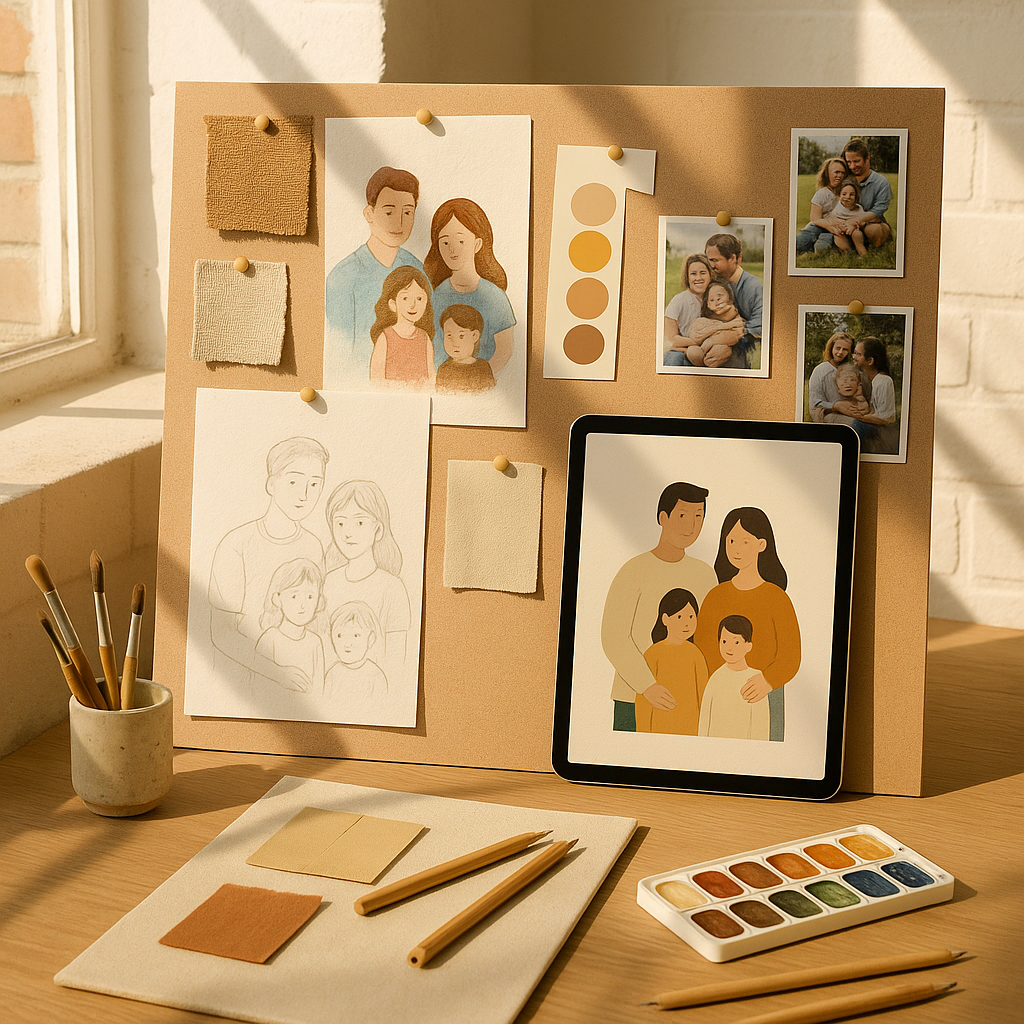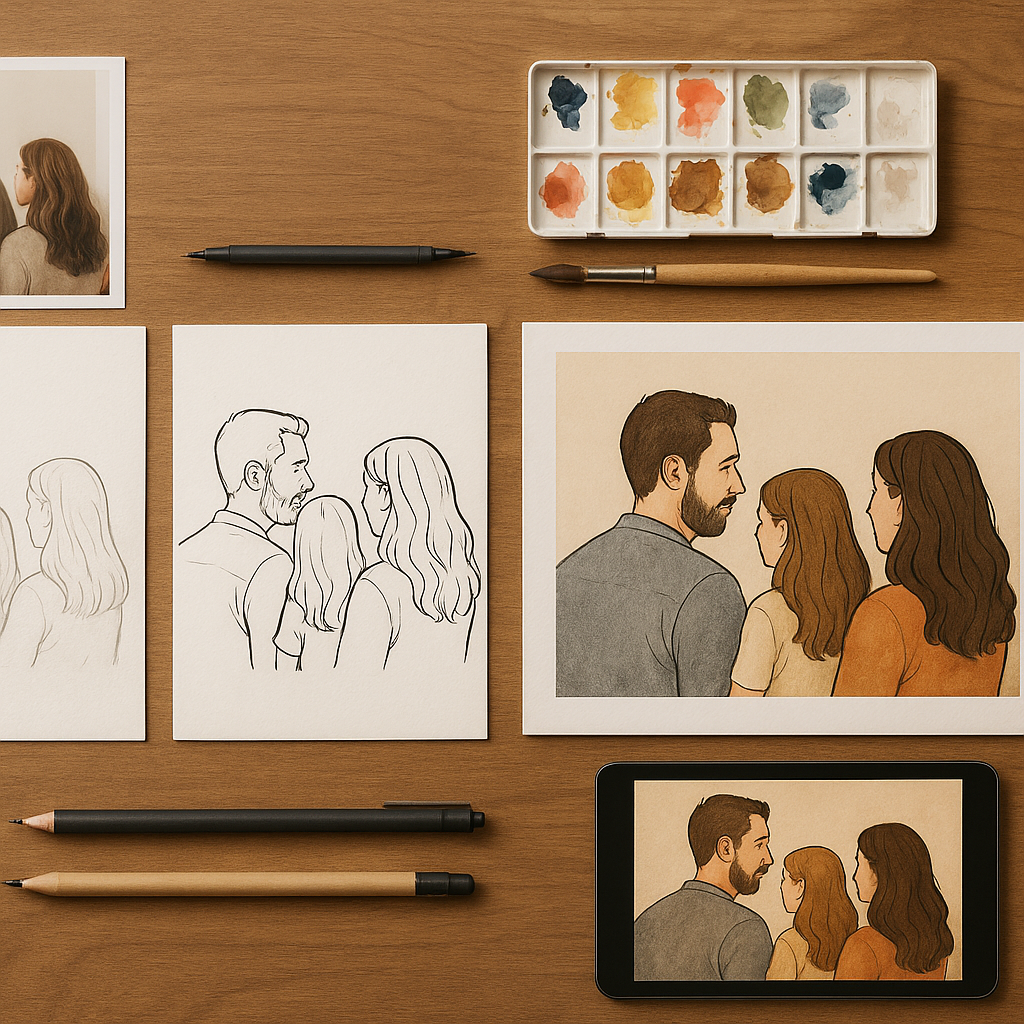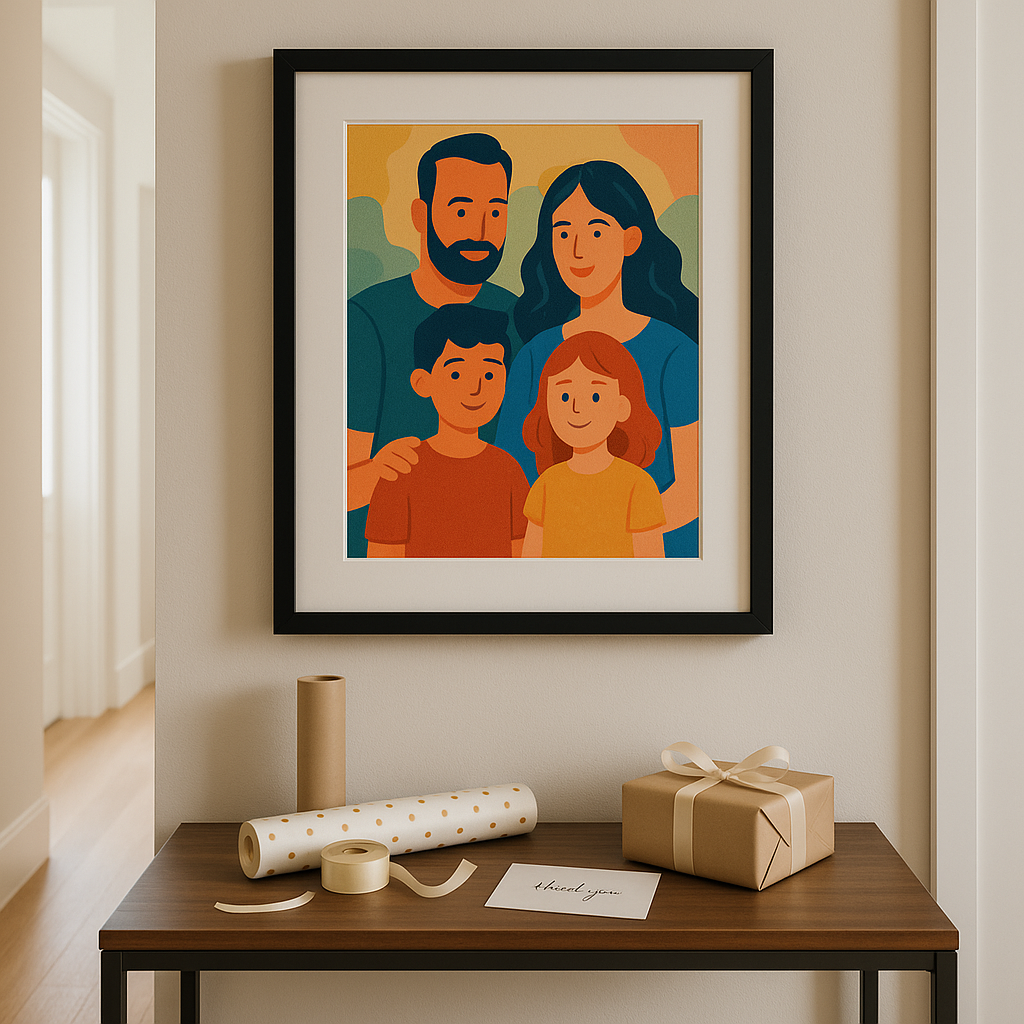
DIY Custom Family Portraits: Tips for a Perfect Keepsake
Share
In today's digital world where memories often remain trapped in our phones, creating a tangible family portrait offers a meaningful way to celebrate your loved ones. DIY custom family portraits have surged in popularity as heartfelt keepsakes that capture not just faces, but personalities and connections. Whether displayed proudly in your home or gifted to a special someone, these personalized creations tell your unique family story in a way that mass-produced items simply cannot.
Throughout this guide, you'll discover how to plan, create, and preserve your own custom family portrait—from choosing the perfect style and materials to troubleshooting common challenges. By the end, you'll have all the knowledge needed to craft a one-of-a-kind family keepsake that will be treasured for generations.
Why choose a DIY custom family portrait?
Creating your own family portrait goes beyond simply capturing likenesses—it's about expressing love through creativity and intention. When you craft something by hand, you infuse it with personal meaning that commercially-produced portraits can rarely match.
The emotional value of making your own family portrait cannot be overstated. Many DIY creators report feeling deeply connected to their families throughout the creative process, often noticing subtle expressions and characteristics they'd previously overlooked.
As one craft enthusiast shared, "While drawing my daughter's smile, I realized she has the same dimple my grandmother had—something I might have missed in our regular rush of daily life."
Beyond the sentimental aspects, crafting your own keepsake offers practical benefits. Custom-ordered portraits can cost hundreds or even thousands of dollars, while DIY versions typically require a fraction of that investment. Additionally, you maintain complete creative control over how your family is represented, from style choices to meaningful details that only you would think to include.
Sentimental value & occasion uses
Custom family portraits shine brightest when connected to significant moments in your family's journey. They make particularly touching gifts for milestone anniversaries, commemorating how a family has grown and changed over time. For new parents, a portrait including their little one serves as a beautiful birth announcement or nursery decoration.
Family reunions present another perfect opportunity for personalized artwork. Consider creating matching portraits for each household or a larger piece showcasing multiple generations gathering together. Many families have established traditions of updating their portraits annually, creating a visual timeline of their evolving story.
For those seeking unique ways to preserve memories beyond traditional portraits, custom lamps featuring favorite family photos and personalized text offer an illuminating alternative that combines functionality with sentiment.
Planning your DIY family portrait: style, materials & inspiration
Before picking up any tools, take time to envision what you want your personalized artwork to become. The planning stage often determines the success of your project, helping you avoid false starts and disappointment.
Start by considering which artistic style best represents your family. Traditional options include realistic pencil sketches, colorful watercolor paintings, or bold acrylic renderings. For something more contemporary, explore silhouette portraits, abstract interpretations, or mixed-media collages incorporating fabric, photographs, and drawings. Digital illustration has also become increasingly accessible, allowing for clean lines and easy editing.
Your chosen style will naturally influence which materials you'll need. For traditional media, invest in quality paper or canvas that can withstand your chosen medium without warping. Artists recommend acid-free papers for longevity and archival quality. If exploring digital methods, consider whether you'll need drawing tablets, styluses, or specific software like Procreate or Adobe Illustrator.
When seeking inspiration, look beyond standard posed photographs.
Many successful handmade portraits incorporate elements that tell a deeper story—favorite activities, memorable vacations, or even beloved pets. Browse platforms like Pinterest and Instagram using hashtags like #familyportrait and #customillustration to discover diverse approaches from artists worldwide.
Digital vs. traditional methods
Each approach to creating family art offers distinct advantages worth considering before starting your project.
Traditional hand-drawn or painted portraits carry a certain warmth and authenticity that many find irreplaceable. The visible brush strokes or pencil marks add character and a genuine human touch. However, they require more confidence in your artistic abilities and offer less room for error—mistakes often mean starting over.
Digital methods provide forgiving environments for creativity, with unlimited undos and the ability to adjust colors, proportions, and compositions with ease. They're particularly suitable for beginners who might feel intimidated by blank paper. Digital works can also be easily reproduced in different sizes or formats. The downside? Some feel they lack the soul and tangible uniqueness of handmade pieces.
For those seeking inspiration on balancing creativity with meaningful personalization, exploring how professionals blend heartfelt sentiment with artistic quality can provide valuable insights for your own creative journey.
Step-by-step guide: how to create your custom family portrait
Creating a personalized family illustration involves several key phases, each offering opportunities to infuse your unique touch. Let's break down the process into manageable steps.
First, select reference photos with care. Ideal images for DIY portrait tips should feature clear facial details, natural expressions, and good lighting. Consider whether to use a single group photo or combine individuals from separate images. For multi-person portraits, choosing photos with similar lighting conditions and head angles will create a more cohesive final result.
Next comes the planning and sketching phase. If working traditionally, lightly outline the basic shapes and proportions using a pencil that can be easily erased. Digital artists should work in layers, keeping the reference photo visible but dimmed. Focus on getting the relationships between facial features correct before adding details—many artists recommend the "eyeline method," establishing where eyes sit on each face as an anchoring point for other features.
When transforming your photo to illustration, pay special attention to what makes each family member recognizable. Is it your daughter's dimpled smile? Your partner's distinctive eyebrows? These defining characteristics deserve extra care.
For traditional media, proceed with adding color and detail in layers, working from light to dark. Digital artists should maintain organized layers for easy editing. Both approaches benefit from periodically stepping back to assess the overall composition and make adjustments.
The finishing touches often make the difference between amateur and professional-looking results. Consider adding meaningful background elements, text overlay with names or a special date, or a unified color scheme that complements your home décor.
Troubleshooting & common mistakes
Even experienced artists encounter challenges when creating family portraits. Recognizing and addressing these issues can save time and frustration.
Proportion problems rank among the most common difficulties. If faces look "off" but you can't pinpoint why, check the relationships between features. The distance between eyes typically equals one eye width, and eyes usually sit halfway down the head. For children's portraits, remember that younger faces have larger eyes and foreheads relative to adults.
Color matching can also prove tricky. When working with physical media, test colors on scrap paper before applying them to your portrait. Digital artists should sample colors directly from reference photos as starting points before adjusting for artistic effect.
If creating multiple faces feels overwhelming, consider simplifying your approach. Stylized portraits with fewer details can be just as charming and often more forgiving than hyper-realistic attempts.
For those who love their completed artwork but want to incorporate it into practical items for everyday enjoyment, custom pillows featuring your portrait offer a comfortable way to showcase your creative efforts.
Display, gift, & preserve: making the most of your creation
Once your personalized artwork is complete, proper presentation and preservation ensure it remains a treasured keepsake for years to come.
For physical artworks, quality framing makes a significant difference in both appearance and longevity. Choose acid-free matting to prevent yellowing and opt for UV-protective glass if the piece will hang in sunlit areas. Custom framing shops can provide guidance on complementary frame styles that enhance your artwork without overwhelming it.
Digital creations offer versatile display options. Beyond standard prints, consider canvas transfers, metal prints for contemporary spaces, or even splitting larger family images across multiple frames for dramatic wall displays. Many online services can transform your digital file into these professional formats with just a few clicks.
When presenting your handcrafted portrait as a gift, thoughtful packaging elevates the experience. Include a handwritten note explaining your creative process or why you chose specific details. Conservation experts recommend including handling instructions if the recipient might be unfamiliar with caring for artwork.
For preserving your family memories in digital form, store high-resolution copies in multiple locations, including cloud storage. Physical artwork should be photographed or scanned before gifting to maintain a record of your creation.
Many families have established creative traditions around their portraits, such as creating annual versions to track how children grow or adding new panels to expand a family tree visualization. These evolving collections become powerful visual narratives of family history.
Conclusion
Creating a DIY custom family portrait offers far more than just a decorative piece for your home—it's a heartfelt journey through memories and connections. The time invested in crafting personalized artwork translates directly into emotional value that commercially-produced alternatives simply cannot match.
Whether you've chosen traditional artistic media or explored digital creation tools, your personalized keepsake captures not just appearances but the essence of your loved ones. The process itself often reveals new perspectives on familiar faces, helping you appreciate subtle expressions and shared characteristics that might otherwise go unnoticed in our fast-paced world.
As you display your finished creation or wrap it thoughtfully for a special recipient, remember that the imperfections and unique stylistic choices make your artwork authentic. These personalized touches transform a simple image into a meaningful family treasure that tells your unique story.
The skills you've developed through this project extend beyond this single creation. Many enthusiasts find that making family portraits becomes an ongoing creative practice, documenting growth and change through updated versions that, over time, create a visual family history unlike any other.
FAQ
What materials do I need for a DIY custom family portrait?
Basic materials include good-quality paper or canvas, drawing/painting supplies or a digital tablet, and a selection of favorite family photos for reference.
Can I make a custom family portrait if I'm not an artist?
Absolutely! There are beginner-friendly techniques and digital platforms that allow you to create beautiful portraits with minimal experience.
What's the best way to turn a photo into a family illustration?
Use tracing methods, digital illustration software, or commission a template, then personalize with unique artistic touches.
How can I personalize my portrait as a gift?
Add names, special dates, or include background scenes meaningful to your family; consider integrating the portrait into custom items like pillows or framed prints.
How do I preserve my DIY custom portrait for years to come?
Frame your artwork with UV-protective glass, keep it out of direct sunlight, or digitize your portrait for backup and sharing.
